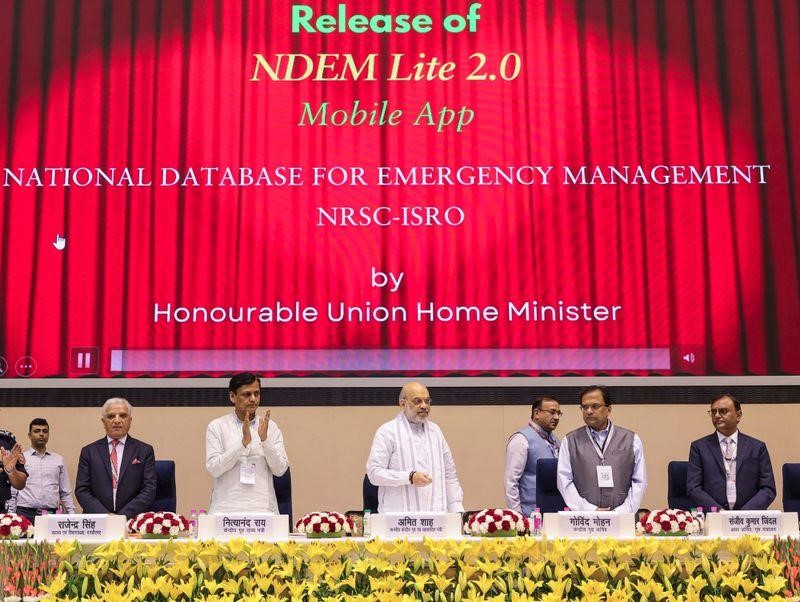Amit Shah Unveils Disaster Management Tech Platforms
Amit Shah Unveils Disaster Management Tech Platforms
Why in the News?
Union Home Minister Amit Shah launched three new technology platforms—ICR-ER, NDEM Lite 2.0, and Flood Hazard Zonation Atlas of Assam—to enhance real-time disaster response, data precision, and flood mitigation efforts across India during a national disaster management conference. These emergency response platforms aim to improve risk assessment and disaster preparedness in the face of increasing challenges posed by climate change and global warming, while also addressing the need for improved speed to market in disaster management solutions.
Key Platforms Launched:
- Integrated Control Room for Emergency Response (ICR-ER): Enables real-time data streaming to rescue agencies across the country for faster emergency responses. This platform enhances crisis communication and supports early warning systems for various disasters, improving real-time response capabilities and the dissemination of early warnings. The ICR-ER incorporates advanced speed measurement technologies to accurately assess the progression of disasters.
- National Database for Emergency Management Lite 2.0 (NDEM Lite 2.0): Offers a centralised digital system to help disaster response forces work in coordination, especially in remote areas. It facilitates disaster recovery planning and improves the overall response of disaster management teams. NDEM Lite 2.0 incorporates satellite-based analysis and satellite data to provide comprehensive information for decision-making during emergencies. The platform’s efficiency is enhanced through optimized cutting speed unit processing, ensuring rapid data analysis without incurring additional network capacity fees.
- Flood Hazard Zonation Atlas of Assam: Provides flood-prone zone mapping, real-time flood data, and river water level monitoring, assisting in flood preparedness. This tool aids in accurate forecasting of flooding patterns and anticipating future disasters in the region. It also supports efforts in regulating development in floodplains to minimize flood-related risks. The atlas utilizes an advanced impact value apparatus to assess potential flood damage and inform mitigation strategies.
Objective and Benefits
- The aim is to equip disaster management systems with cutting-edge technology to increase speed, accuracy, and coordination in mitigation in disaster management. These platforms are integral to comprehensive disaster management plans that focus on prevention, preparedness, and response. The initiatives also address how to improve speed in emergency response times, a critical factor in saving lives during disasters.
- These tools will enhance data accessibility for officials, reduce response time, and improve decision-making in emergencies, supporting a more integrated approach to tackling disasters. The ultimate goal is to achieve zero casualty during natural calamities through improved preparedness and response, learning from past events such as the Kedarnath calamity.
- The platforms help create a single operational framework for diverse disaster response teams, promoting a comprehensive approach to disaster management. By optimizing data processing and minimizing network capacity fees, these systems ensure cost-effective and efficient disaster management operations.
National and Regional Impact
- ICR-ER and NDEM 2.0 offer nationwide emergency coordination, enabling better inter-agency collaboration and supporting relief and rescue operations across the country. These platforms enhance the capability for real-time response to various types of disasters.
- The Assam flood atlas is tailored to assist local authorities and flood control authorities with predictive analysis and mitigation planning, addressing recurring flood issues in the state. It provides crucial information on water levels in rivers and historical flooding patterns, supporting the development of flood resilient agriculture practices in the region. This data also informs the implementation of crop insurance schemes to protect farmers from flood-related losses.
- These technological advancements contribute to environmental conservation efforts by improving our ability to respond to and mitigate the impacts of natural disasters, which are often exacerbated by climate change and global warming.
The launch of these platforms represents a significant step forward in India’s disaster management capabilities. By leveraging real-time data and advanced research, these tools promise to enhance the country’s ability to anticipate, prepare for, and respond to a wide range of disasters. This integrated approach to disaster management, combining technology forecasting and social change, aims to minimize casualties and improve overall resilience in the face of natural calamities. The optimization of these systems, including the reduction of network capacity fees, ensures that these advanced capabilities are delivered in a cost-effective manner, maximizing the impact of disaster management resources.




